One of the Earliest Memorial Day Ceremonies Was Held by Freed Slaves
At the close of the Civil War, freed slaves in Charleston honored fallen Union soldiers.
(History.com) Memorial Day was born out of necessity. After the American Civil War, a battered United States was faced with the task of burying and honoring the 600,000 to 800,000 Union and Confederate soldiers who had died in the single bloodiest military conflict in American history. The first national commemoration of Memorial Day was held in Arlington National Cemetery on May 30, 1868, where both Union and Confederate soldiers are buried.
Several towns and cities across America claim to have observed their own earlier versions of Memorial Day or “Decoration Day” as early as 1866. (The earlier name is derived from the fact that decorating graves was and remains a central activity of Memorial Day.) But it wasn’t until a remarkable discovery in a dusty Harvard University archive the late 1990s that historians learned about a Memorial Day commemoration organized by a group of freed black slaves less than a month after the Confederacy surrendered in 1865. (more)
These photos capture the lives of African American soldiers who served during World War II
Pittsburgh photographer Teenie Harris focused on the patriotism of men who fought for the country abroad while being discriminated against at home
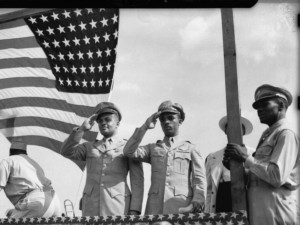
Two men wearing U. S. Army uniforms, including Major George S. Roberts (on left), June 22, 1944 (Charles “Teenie” Harris © Carnegie Museum of Art, Charles “Teenie” Harris Archive)
(Smithsonian Magazine) Teenie Harris knew everyone, and everyone knew him.
From the 1930s to the 1970s, Charles “Teenie” Harris worked as a photojournalist for the Pittsburgh Courier, one of the most influential black newspapers of the 20th century, capturing the everyday experience of African American life in the Steel City. His photographs depicted a black urban community that, despite the segregationist policies and racist attitudes of mid-century America, was innovative, thriving, and proud. (His camera is in the collections of the Smithsonian’s National Museum of African American History and Culture.)
During World War II, African Americans from Pittsburgh and all around the country fought and died abroad even as they were marginalized at home. Through his photography, Harris captured the realities—points of pride and points of sorrow—of a “separate but equal” service to one’s country, through his coverage of the Double Victory campaign, a nationwide effort launched by the Courier to enlist African Americans to fight for their country and their rights at home.
Harris also photographed over 1,500 soldiers in his studio, located on Centre Avenue in Pittsburgh’s Hill District; these portraits were a part of his contribution to the war effort. His images preserve the legacy of black patriotism during a time of visible discrimination.
The unique experiences of those black soldiers frame the conversation of this photo essay, which includes selections from the more than 80,000 photographs, negatives and film that comprise the Teenis Harris Archive at the Carnegie Museum of Art. (more)
Howard University Graduate Makes History as Air Force Thunderbird
(NBC Washington) All across the country, U.S. Air Force Thunderbirds have been performing flyovers to honor the workers on the front lines of the coronavirus pandemic. One of the team’s newest members is a Howard University graduate and the first black, female officer.
“I know a small percentage of African-American officers, specifically female officers in the Air Force. So to be in a position that is visible, to show little girls that this is attainable, to let them know they can do anything they put their mind to, is an absolute honor,” Capt. Remoshay Nelson said.
This is Nelson’s first season with the Air Force Thunderbirds squadron. Shows have temporarily been placed on hold because of the coronavirus, but they have conducted flyovers across D.C., Baltimore and Atlanta to pay tribute to people battling the pandemic. (video)
TIPHC Bookshelf
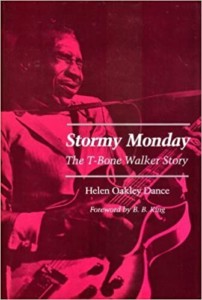 Published scholarship on black history in Texas is growing and we’d like to share with you some suggested readings, both current and past, from some of the preeminent history scholars in Texas and beyond. We invite you to take a look at our bookshelf page – including a featured selection – and check back as the list grows. A different selection will be featured each week. We welcome suggestions and reviews. This week, we offer, “Stormy Monday, The T-Bone Walker Story,” by Helen Oakley Dance.
Published scholarship on black history in Texas is growing and we’d like to share with you some suggested readings, both current and past, from some of the preeminent history scholars in Texas and beyond. We invite you to take a look at our bookshelf page – including a featured selection – and check back as the list grows. A different selection will be featured each week. We welcome suggestions and reviews. This week, we offer, “Stormy Monday, The T-Bone Walker Story,” by Helen Oakley Dance.
The most significant factor in the career of Aaron “T-Bone” Walker, a Linden, Tx. native, was his ability to bridge the worlds of blues and jazz. The guitar artistry of this early exponent of urban blues was not only admired by blues musicians like B.B. King, Gatemouth Brown, Albert King, and Albert Collins, and rock guitarists such as Eric Clapton, Jimi Hendrix, Duane Allman, and Stevie Ray Vaughan, but by such jazz greats as Billie Holiday, Dizzy Gillespie, Lester Young, and many others with whom he recorded.
Stormy Monday is the first biography of T-Bone Walker to be published. Using dozens of interviews with Walker, as well as with members of his family, close friends, fellow musicians, and business associates, the book offers a remarkable frank insider’s account of the life of a blues musician and compulsive gamble, from the wild living and hard-drinking on the road to a solid and contented family life at home.
“In a very real sense the modern blues is largely his creation.” blues authority Pete Welding has written about T-Bone Walker. “The blues was different before he came on the scene, and it hasn’t been the same since, and few men can lay claim to that kind of distinction. No one has contributed as much, as long, or as variously to the blues.”
This Week in Texas Black History
May 24
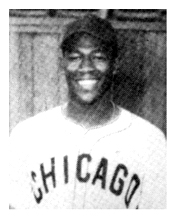
Former Negro Leagues star and Tuskegee Airman John “Mule” Miles died on the day in 2013 at age 91 in his home town, San Antonio. During World War II, he served as a mechanic for the 99th Pursuit Squadron. After that, he played for the Chicago American Giants from 1946 to 1949 and in 1947 hit 11 home runs in 11 straight games, a feat that has never been equaled. Giants’ manager Candy Jim Taylor, gave Miles his nickname saying that he “hit like a mule kicks.” Miles played alongside such greats as Jackie Robinson, Hank Aaron, and Satchel Paige.
May 25
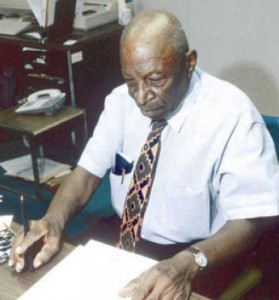
Pioneering journalist George McElroy, “Mr. Mac,” was born on this day in 1922 in Houston. McElroy was the first black columnist for the Houston Post, and was also the first African-American to earn a master’s degree in journalism from the University of Missouri, which he attended on a scholarship from the Wall Street Journal. McElroy began his career at age 16 earning $2 a week writing a youth column for the Houston Informer, the city’s oldest black newspaper. Years later, he became the paper’s executive editor. McElroy, the recipient of numerous honors, taught journalism at Houston’s black high schools, as well as Texas Southern University (his alma mater) and the University of Houston.
May 25
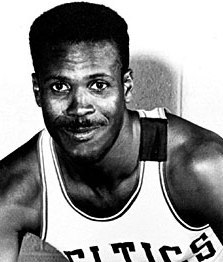
Professional basketball great K.C. Jones was born on this day in 1932 in Taylor. At age nine, he moved with his mother to San Francisco where he starred in football and basketball at Commerce High School. At the University of San Francisco, Jones teamed with Bill Russell in leading the Dons to 56 consecutive wins and back-to-back NCAA championships in 1955 and 1956. Jones also played professionally with Russell on the powerful Boston Celtics teams as a defensive standout in late 1950s and 1960s. He was also a member of the 1956 U.S. Olympic Basketball Team that won a gold medal at Melbourne, Australia. Jones won eight championship rings as a player, one as an assistant coach with the Los Angeles Lakers, one as an assistant coach with the Celtics, and two as head coach of the Celtics. He was inducted to the Naismith Memorial Basketball Hall of Fame in 1989.
May 28
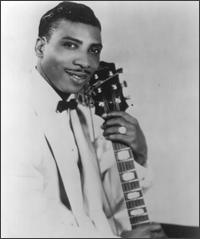
On this day in 1910, guitarist Aaron Thibeaux Walker, “T-Bone,” was born in Linden. Walker became one of the most influential musicians on the blues scene and his 1947 hit, “Call It Stormy Monday,” is a blues standard. Walker grew up in Dallas and as a teenager led bluesman Blind Lemon Jefferson around the city collected tips for Jefferson’s street performances. Walker revolutionized the blues as one of the first (possibly THE first) to perform with an electric guitar. A great showman, Walker would play the guitar behind his head while doing the splits or play the guitar with his teeth. His performance style influenced artists like Chuck Berry and Jimi Hendrix. Walker was awarded a Grammy in 1970 for his album “Good Feelin’“. He was inducted to the Blues Hall of Fame in 1980 and the Rock & Roll Hall of Fame in 1987. He was ranked 47th on Rolling Stone magazine’s list of The 100 Greatest Guitarists of All Time.
May 29
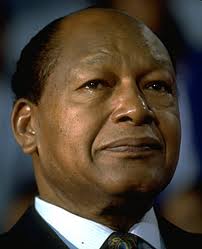
On this day in 1973, Calvert, Texas native Tom Bradley was elected as the first African American Mayor of Los Angeles. Bradley served for twenty years which is longer than any other mayor of the city. Born the son of sharecroppers and the grandson of a slave in Calvert, Bradley was instrumental in much of Los Angeles’s growth and it’s hosting of the 1984 Summer Olympics. Los Angeles became the nation’s second most populated city under his administration. Upon retiring from Mayor in 1993, Bradley ran unsuccessful campaigns for Governor of California in 1982 and 1986.
Blog: Ron Goodwin, Ph.D., author, PVAMU history professor
Ron Goodwin is an assistant professor of history at Prairie View A&M University. Even though he was a military “brat,” he still considers San Antonio home. Like his father and brother, Ron joined the U.S. Air Force and while enlisted received his undergraduate degree from Texas Lutheran University in Seguin, Texas. After his honorable discharge, he completed graduate degrees from Texas Southern University. Goodwin’s book, Blacks in Houston, is a pictorial history of Houston’s black community. His most recent book, Remembering the Days of Sorrow, examines the institution of slavery in Texas from the perspective of the New Deal’s Slave Narratives.
Recent Posts
It’s OK now
Hopefully, this COVID-19 pandemic will end soon, and life can get back to normal. At the very least, as a society, I hope we’ll learn how to live with it. But one day, our intelligentsias will analyze every governmental action since February and March of 2020, especially those of the President. Recent policies have addressed the numbers of individuals who are out of work because of the “stay at home” directives. It’s been called… (more)
WWJD
Several years ago, these letters, “WWJD?” seemed to be everywhere. We all know they represent “What Would Jesus Do?” I think these letters and the question were meant to challenge society to consider the moral implications of their everyday decisions. Now in this new COVID-19 reality, WWJD may have new meaning. Since my father…(more)
Submissions wanted
Historians, scholars, students, lend us your…writings. Help us produce the most comprehensive documentation ever undertaken for the African American experience in Texas. We encourage you to contribute items about people, places, events, issues, politics/legislation, sports, entertainment, religion, etc., as general entries or essays. Our documentation is wide-ranging and diverse, and you may research and write about the subject of your interest or, to start, please consult our list of suggested biographical entries and see submission guidelines. However, all topics must be approved by TIPHC editors before beginning your research/writing.
We welcome your questions or comments. Please contact Michael Hurd, Director of TIPHC, at mdhurd@pvamu.edu.

